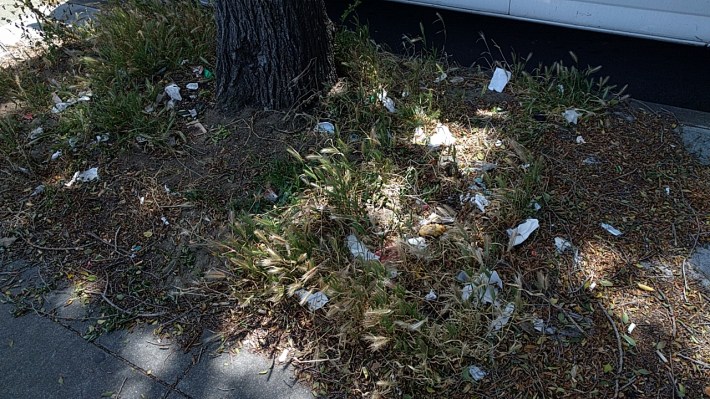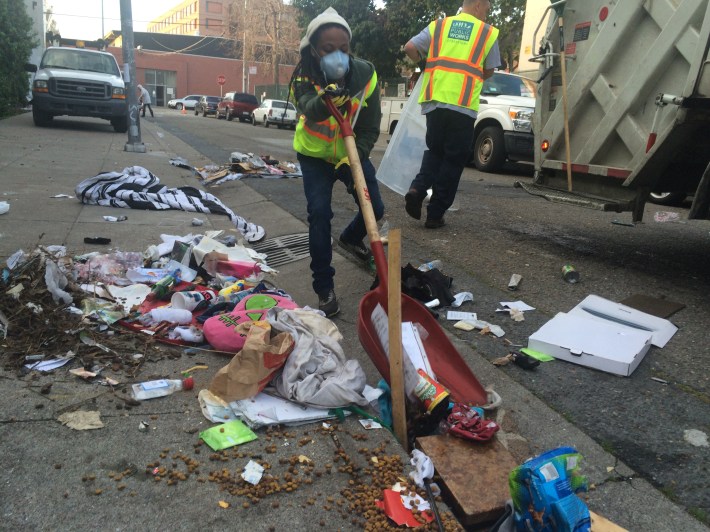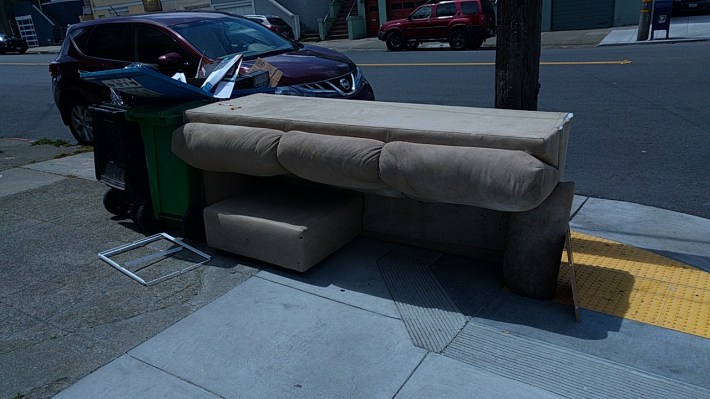
A few weeks ago, I found an apartment in the Outer Mission. It had a view of Twin Peaks, plenty of room, and it was in my price range. It is a short bike ride to the great transportation links at Balboa Park Station. It also was a half-block from a stop on the 14-Mission bus. There's a nice cafe down the street, a couple of small markets within a few blocks, and pretty much everything a Livable Streets advocate could ask for, except for bike lanes, but hopefully those will come.
As I negotiated with the owner, I started hanging out in the area as much as possible, to see how I liked it. Almost right away, I noticed a lack of pedestrian traffic. Despite Lincoln Park and the Cayuga Playground, both a few blocks away, a large supermarket on Alemany, and some nice restaurants, and a fair amount of car traffic, I saw virtually nobody out walking.
And there was a whole lot of trash. At first I thought it was because of the powerful winds that came through a few days prior; perhaps they had blown over some trash cans. But the litter stayed. Nobody swept up in front of their shops. As I explored further, I noticed even more trash.
What struck me even more was the stark contrast with the neighborhoods on the other side of I-280. Less than two miles to the west I could find litter if I looked for it, but I wasn't tripping over it. On the weekends, I saw people outside cleaning up their front yards and sidewalks with rakes and brooms. Same with graffiti: to the west of I-280, it's there, but harder to find. East of I-280, it's pretty prominent.

In 2014, the City and County of San Francisco commissioned the firm HDR to study the percentage of litter related to tobacco products, as part of an audit to determine appropriate costs and taxes on cigarettes. The results of the study are informative and available to peruse online (PDF). It showed that the city is generally getting cleaner. It also showed that tobacco products account for a disproportionate amount of litter. And it showed that depending on the block or corner, the amount of litter varies widely, from a low of 42 pieces of litter found to a high of 260. In addition, it seems much of the cleanliness comes from individual action, not necessarily because the city cleaned it up. To quote the study:
Business owners approached the team during the site analysis to inform them that they took responsibility for cleaning the sidewalks and streets near their places of business. Overall, the sites were cleaner in 2014 than they were in 2009.
From the Department of Public Works Website:
We partner with property owners to maintain the highest standards of cleanliness along San Francisco’s busiest neighborhoods and commercial corridors to keep them safe, beautiful and inviting. Our staff are out on the streets, sometimes before the sun rises, to inspect rights of way, enforce codes and educate merchants and residents about City codes.
So is the problem simply that on some blocks people don't care--or don't know how to contact the city and get things cleaned up? Is this a squeaky-wheel-gets-the-grease kind of situation, and in some areas, there's just nobody squeaking, to play out the metaphor?
Rachel Gordon, a spokeswoman for the San Francisco Public Works Department, said there's a host of reasons for why one neighborhood will get littered and another stays clean. "Sometimes it's just the wind, but other times it's how much traffic the area gets." Drivers, she says, tend to throw things out windows. But pedestrian traffic can result in more litter too, especially in areas with a large number of Single Room Occupancy dwellings (SROs). She identified the Tenderloin as an area they have to clean up frequently. The department has about 80 people from the Department of Human Services that they send out with "sweep up crews" to collect litter.
That said, it's legally the responsibility of business owners and residents. "You have a responsibility to keep your property and sidewalk free of litter and bird droppings, dog poop, everything--it's your responsibility to clean," Gordon said. She also said there's a contagion effect: if residents and business owners clean up, visitors are less likely to litter. But if people in an area say, "That's not my garbage, I'm not picking it up," then they invite more littering. "You want to take pride in your neighborhood; if the street is clean and you keep things maintained then people are more likely to take care," said Gordon.
That's why the department hopes more people will join its "Community Clean Up Teams," and spend a Saturday or two picking up trash. The next group of volunteers is going out on Saturday, June 18. And there's the "Adopt a Street" program. From the DPW website:
The Adopt-A-Street Program is a partnership between the City and its merchants and residents. Groups or individuals agree to adopt an area and take responsibility for keeping the street, sidewalk, and storm drain clean. In return, we provide free street cleaning supplies, and litter and compostable leaf bag pickup.


The Public Works website, meanwhile, explains how to complain, because 311 complaints do help get trouble spots cleaned up:
To report:
- illegal dumping
- improperly disposed of needles and medical waste
- human waste in the public right of way
you can visit 311 online, use the mobile SF311 app or call 311. Our goal is to remove waste that is our responsibility within 48 hours during week days. An action plan will be developed for projects that require more than 48 hours to address. Before you call, please determine the street address and the nearest cross-street where the waste is located.
Meanwhile, it was a tough decision about the apartment. I thought about taking it and trying to organize one of the city's clean-up teams. But the owner was honest and said litter's been an ongoing problem. As he said, "If you're a guy who likes to walk and ride a bike, maybe this area is not so good for you." Gordon, meanwhile, said she is going to try and get some clean up crews out to the block.
Do you live or work in an area that's heavily littered? What do you think is the root cause? How does it relate to livable streets? And what have you done, if anything, to try and fix the problem?





